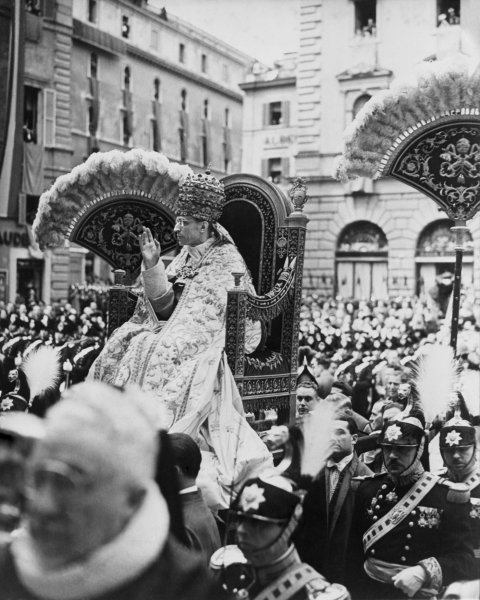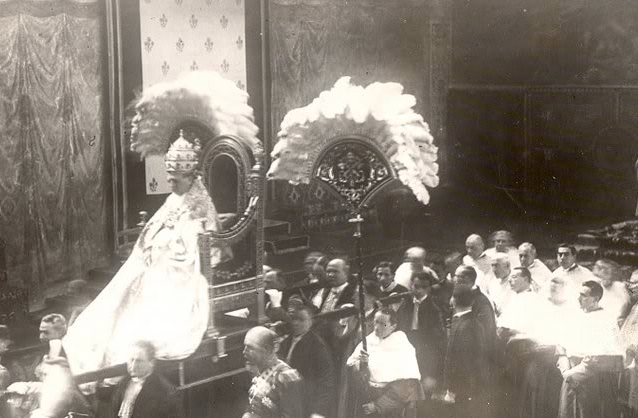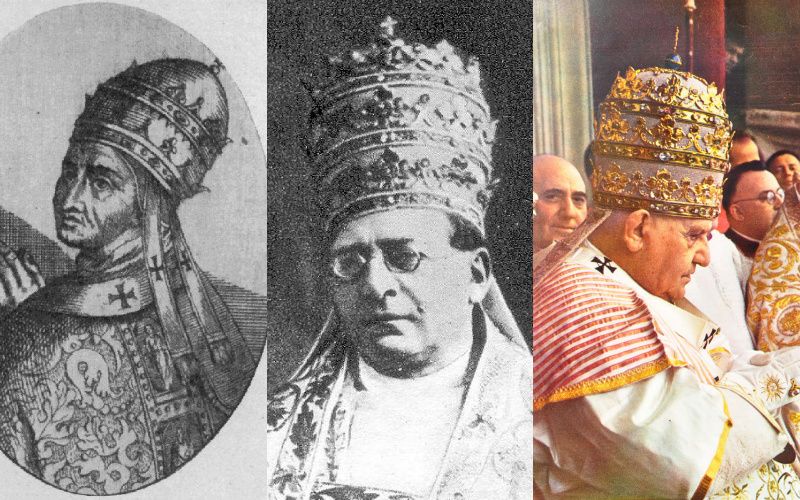Today, Pope Francis is known for his relative simplicity. He doesn’t seem to particularly like the more traditional, ornate papal regalia and signs of power.
[See also: QUIZ: Can You Identify These Liturgical Objects?]
[See also: The Lost 1200-Year-Old Wonder: A Tour of the Old St. Peter’s Basilica]

In particular, notice that he doesn’t even wear the traditional red shoes (the color red symbolized the blood of martyrs).
To understand how unique this is for the papacy historically, you have to keep in mind that just a few decades ago, this kind of thing was normal:

This is Pope Bl. Paul VI presiding over the Second Vatican Council in the 1960s.
And this is how popes got around:

In this second one, notice that Pope Ven. Pius XII (pope 1939-1958) is not only being carried in a chair, he’s wearing the traditional papal tiara, a three-tiered crown.
Yep: not only did popes used to wear crowns, they would wear a tiara with three crowns. And they had done so for centuries.
The Origins of the Papal Tiara
Historians aren’t completely sure about when the papal tiara was first used. The first mention of some sort of papal crown dates to the 8th century, and artwork from the time period shows popes wearing a cone-shaped helmet with a small crown attached to the bottom

The first mention of the word tiara being used to describe the headgear of the pope dates to around the early 12th century.
Sometime in the 13th century, a second crown was added. The two crowns apparently symbolized the fact that the pope had authority over both spiritual matters and, ultimately, temporal matters, and also distinguished the pope’s tiara from single-tier monarchial crowns.

In the 14th century, a third crown was added. The exact intended meaning of the three crowns is not clear, and a wide range of interpretations have been offered over the centuries. Some say the three crowns represent the threefold office of Christ, priest, prophet, and king; another interpretation says they represent the bishop of Rome’s roles as the Universal Pastor, as having universal ecclesiastical jurisdiction, and having temporal power. Whatever the meaning, the three-tiered papal tiara was used for the next six centuries.

Interestingly, Suleiman the Magnificent, the Muslim Sultan of the Ottoman Empire in the 16th century, had a four-tier crown created, apparently to one-up the three-tiered crown worn by the bishop of Rome.

Papal tiaras in their various forms were used in papal coronation ceremonies from at least the 12th century until late 20th century.
The End of a Tradition
The long tradition of the papal tiara came to a dramatic end in 1963. At the end of the second session of the Second Vatican Council, Pope Bl. Paul VI descended from this papal throne in St. Peter’s Basilica, went up to the altar, and placed his papal tiara on the altar. He did this to symbolize a renunciation of worldly glory for the papacy.
The tiara was sold to Catholics in the U.S., with the proceeds going to the poor. His tiara – the last one worn by a pope so far – is now on display in the crypt of the Basilica of the National Shrine of the Immaculate Conception in Washington D.C.:

Although Paul VI had given up his papal tiara, the plan he left for papal elections still included a papal coronation. But when John Paul I was elected, he decided to forego the traditional papal coronation ceremony and just not receive a papal tiara at all. And when St. John Paul II assumed the papacy a few weeks later, he followed John Paul I’s precedent, and so did Benedict XVI and Francis.
Even so, the papal tiara as a pure symbol is still used in some cases.
For example, here is the coat of arms of Vatican City:

Of course, a pope could decide to revive the custom at any time and start wearing a papal tiara, though it seems unlikely for the time being.
Some Catholics have been critical of Paul VI for giving up the practice, given that it was such a long-standing symbol. Others say the papal tiara no longer made sense as a symbol in our era, and Paul VI was right to retire it.
Here are some photos of a few 20th century popes wearing the papal tiara:
Pope Bl. Paul VI:

Pope St. John XXIII:

Pope Ven. Pius XII:

Pope Pius XI:

Pope Benedict XV:

Pope St. Pius X:

What do you think? Are you glad popes no longer wear the tiara? Or should a pope bring it back?
[See also: QUIZ: Modernist Church or Communist Building?]
[See also: QUIZ: Are You a Heretic?]

